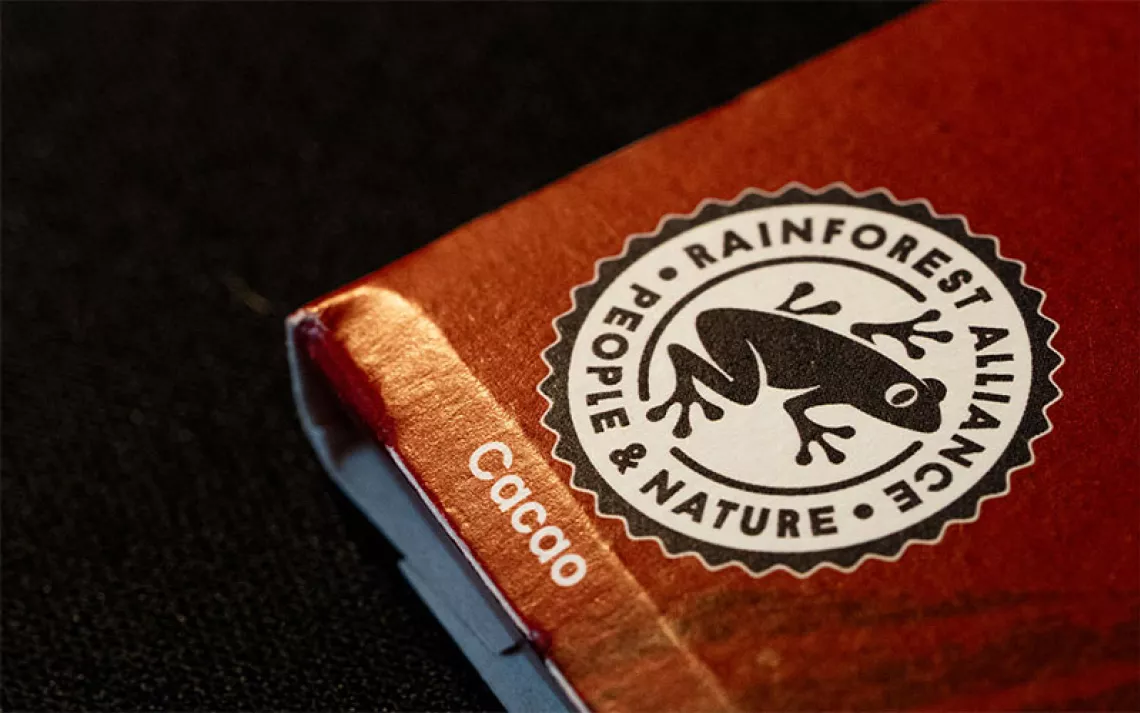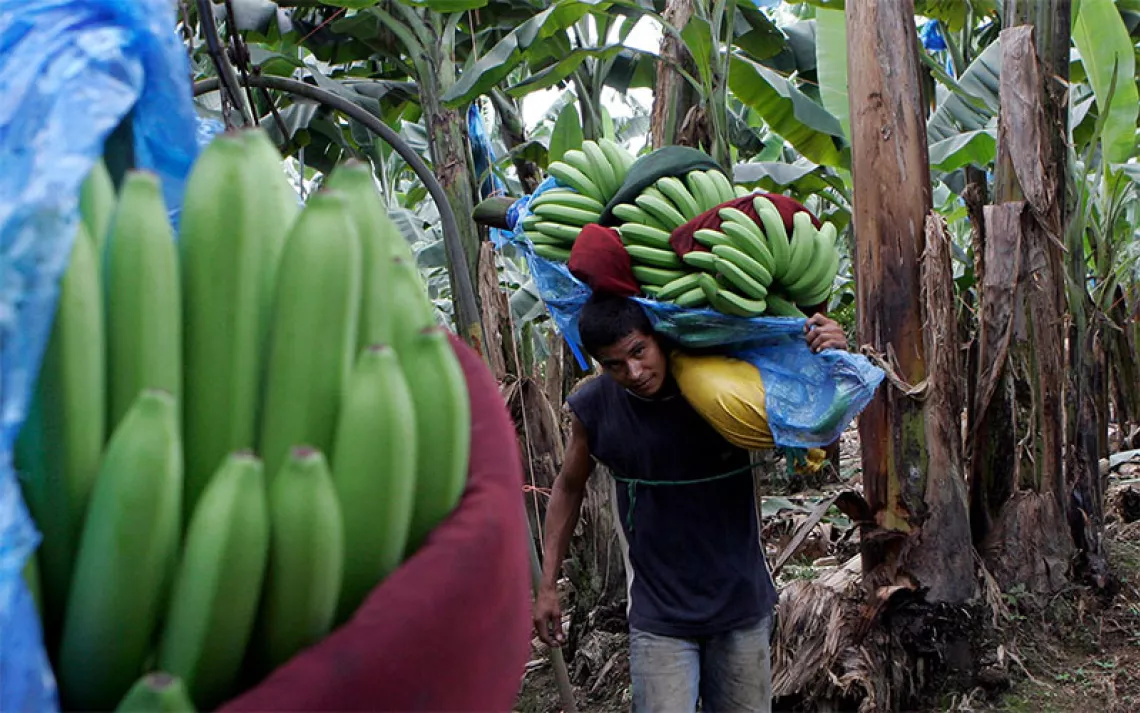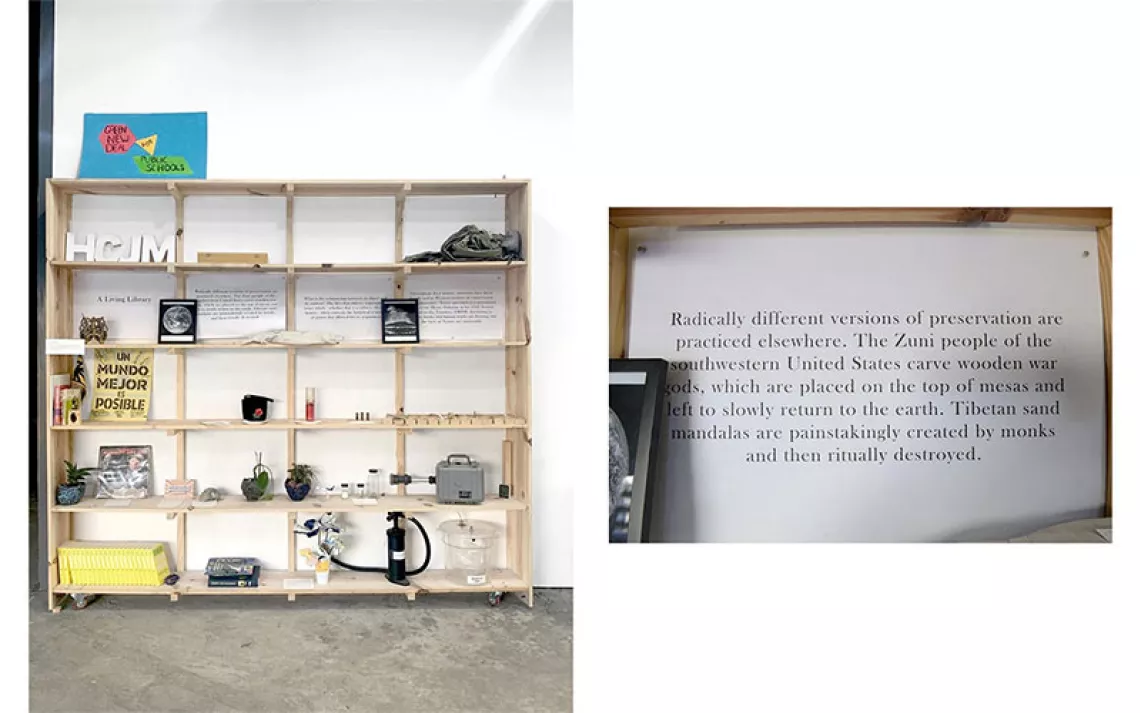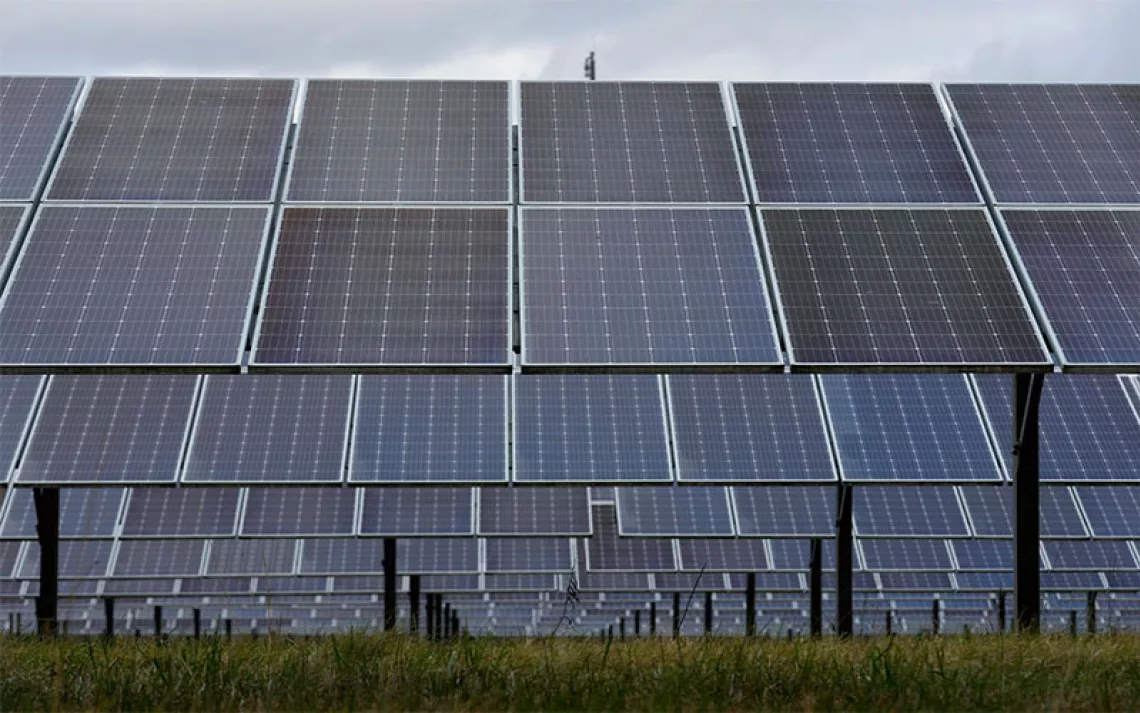Meet the Climate Justice Influencers
The future of environmentalism is intersectional. And on Instagram.
In early July, Diandra Marizet—a self-proclaimed “conscious curator”—posted a selfie on Instagram. In the post, she's tilting her face to catch the light, and so her dark, cascading curls frame her face. Swipe, and upbeat music tracks a video of her applying a rosy color on her lips, then flashing this wide, perfect smile.
In Marizet’s caption, she does promote the product she’s using on her lips, which is exactly what you’d expect a beautiful woman with thousands of followers to be doing on Instagram. But the lip product is plastic- and cruelty-free, she tells you, and the ingredients are clean. All this is after a long caption about colorism—about how when she was younger she was warned not to play outside too much, because it would make her skin darker.
Marizet (@diandramarizet) is Mexican American, and she’s been talking about sustainability and justice in the fashion and beauty industries for years now. In her bio, she bills herself as an “advocate for people + the planet.” She’s a new kind of activist, making use of social media to educate people about the effects of climate change on communities of color. Much like traditional influencers, Marizet leads with her personality, inflecting each information-dense caption with humor, style, and plenty of emojis. Scrolling her feed makes you feel like she’s your very cool, very smart friend. On the occasion Marizet posts a video, her personality comes to life, her hands following the rhythm of her thoughts like a dance.
Marizet has been interested in sustainability for a long time, but her activism didn’t really bud until she was working in retail in New York. She got interested in how the products she peddled were made—who was exploited and what sort of carbon footprint they left. She made friends who were interested in the same, and they started meeting in coffee shops or in their “tiny matchbox apartments” to talk about sustainability. Slowly, through these conversations and through Instagram, she started connecting with other young people of color who cared about the environment. Increasingly, she discussed what she was learning on social media, sharing her questions and discoveries, her lifestyle tips and thrifted looks. Her following grew and grew.
And so did her community. Nowadays, there are dozens of young environmental activists of color on Instagram, many of whom are using the platform to uplift their stories and share their work. Recently, they came together under the platform Intersectional Environmentalist, which Marizet cofounded.
What is intersectional environmentalism, and how did we get here?
In working to protect the planet, this inclusive form of environmentalism also seeks to protect people, addressing issues like environmental racism, or the disproportionate impact of pollution on communities of color. A few months ago, phrases like “environmental racism” and “intersectional environmentalism” were virtually unrecognizable outside of the environmental community‚ and in some cases, even within it.
Then, Black Lives Matter protests swelled in the wake of George Floyd’s death, and suddenly social media alighted with activist sentiment. Twitter lives and thrives in this sort of fevered, news-hungry state, and Facebook has long been the source of questionable political rants from distant relatives and old classmates. But Instagram? Instagram was an apolitical haven: all bikini pics and aerial views of decadent brunches and beautiful people in beautiful places with their beautiful friends.
As with other social media platforms, your experience on Instagram is determined by its algorithm. When your Instagram feed stopped being chronological in 2016, the content that floated to the top was that which was on trend, well-liked, and well-commented. This made it possible for influencers to flourish, in most cases following a similar mold: a beautiful young woman posting pictures of herself, alone or with other influencers. A profit model soon suckered on, and before long influencers were peddling sponsored products on the decks of their sprawling homes, afforded by Instagram.
But then 2020 struck. The US was in crisis, and its citizens, from the confines of their state-mandated stays at home, were trying to reckon with over 400 years of institutional oppression. People who had spent years talking about racial justice saw their following explode, as seemingly everyone raced to educate themselves and others. Suddenly, acting against systems of oppression became not just a moral imperative but a social one too. In the ecosystem of Instagram, that involves signaling that you are acting.
As infographics got traded around via Instagram stories (that’s where users post photos, videos, and memes that vanish after 24 hours) and feeds flared with informational videos, I kept seeing the same one: A beige square with 16 lines of earth-toned text, all proclaiming the same message: “Environmentalists for Black Lives Matter.” Swipe, and you get a concise definition of intersectional environmentalism. Swipe again, and you see an eight-pronged intersectional environmentalist pledge. Digestible. Sharable. Actionable.
The post was created by Leah Thomas, the woman behind @greengirlleah. It went viral, uplifting a whole network of communities that have been doing this work for years.
So Thomas, along with Marizet and two other activists (@sustainablesabs and @philthefixer), created Intersectional Environmentalist as a platform to build a diverse community of climate activists and spark new conversations about sustainability and environmentalism.
In typical social media fashion, the influencers behind Intersectional Environmentalist offer something for everyone. Fashion, beauty, plants, zero-waste living, outdoor recreation—whatever you’re interested in, there’s an account dedicated to the sustainable, intersectional version of it. Some tilt more toward infographics, others toward videos, but all of them rely on the shining, sharable personality of the Instagrammer to edge other Instagrammers along their environmentalist journeys.
“We all do similar things but share different information,” Kristy Drutman told Sierra. Drutman, who identifies as Filipina and Jewish, runs the Instagram and podcast @browngirlgreen. “I don't talk about sustainable brands. I focus more on social justice or on-the-ground activists. We’re creating this whole content ecosystem. It feels like we’re all contributing to this canon of social media education.”
Who are these new activists?
Historically, we’ve tended to lift up environmental leaders who were white men, many of whom were openly racist. Young activists of color have been pushing against the whitewashing of environmental issues for years—trying to diversify the community by highlighting the important conservation contributions that people of color have made throughout history.
Communities of color often live in the most polluted areas and have less access to green space and other public lands. This reality—aptly termed environmental racism—has long excluded people of color from conversations around conservation and sustainability.
“We’re bearing the burden, but we’re also being locked out of the solution,” says Sahir Doshi, a researcher for the Center for American Progress. He recently coauthored a report about the “nature gap,” detailing how communities of color nationwide have less access to nature than white communities. “There are very overt racist policies from history, like redlining and forced migration, and less overt factors like the prioritization of different communities for new parks, new protected areas.”
Enter the social media activists. Via Instagram posts, they talk about their own backgrounds living in polluted communities or feeling excluded from the environmental movement. They share how they came to learn about environmental racism and environmental justice and how they are working to become more sustainable in their day-to-day lives.
Though some resist the term “influencer,” most follow a pretty established aesthetic playbook. They center themselves in photos; their captions are personable and casual; they allow you into their lives, sharing their stories.
These methods help them gain traction but also serve the goal of changing the face of the environmental movement—through social media, activists of color are making themselves and their stories visible. For some, getting comfortable sharing themselves online is a difficult and ongoing practice.
“It takes time to be able to speak your truth in a way that makes sense and that you actually trust it,” Drutman says. “Using a platform to be relatable rather than a spokesperson takes confidence and vulnerability.”
That vulnerability is often a huge part of the message, as is admitting they’re learning. It was a sentiment I heard over and over again: Their platform changes as they change.
It’s a marked departure from the expert-driven, technocratic discourse at the center of a lot of climate conversations. Environmental policy wonks or atmospheric scientists have long been the token interviewees in gloomy climate change documentaries. And of course, heeding the science is fundamental to achieving our climate goals. But it can also feel exclusive, and inaccessible, locked behind academic journal paywalls and tangled up in science-speak.
Scrolling through any of these Instagram feeds feels very different. These influencers are on their own journeys, as they will readily tell you, and they’re teaching as they’re learning. They’re willing to be wrong, willing to admit that topics are difficult, and willing to invite you into their education process.
For Marizet, this also means being honest about how little she knows her own culture’s ancestry and its history of caring for the earth.
“I want to openly be a novice of it,” she says. “It highlights how that has been stripped from me and my community. I don’t know the answers, because I wasn’t taught. I'm a Mexicana from Texas, and I don’t know my culture beyond the stereotypes that I grew up in.”
Beyond reconnecting to their cultural history of environmental stewardship, many climate justice influencers are identifying the ways in which their families lived low-waste lives without ever calling it sustainable.
“I think for me, growing up, that was known as you just being poor,” says Isaias Hernandez, the Mexican American environmental educator behind @queerbrownvegan. In Los Angeles, his family recycled for money, reused, and were resourceful because they couldn’t afford to be constantly buying new things. It wasn’t celebrated like zero-waste environmentalists are.
Joycelyn Longdon, the UK-based creator behind the account @climateincolour, had a similar experience. She says her mother would “never say she’s zero-waste,” but that she would use the same Tupperware for years. Instead of being championed, as a Black woman Longdon felt disenfranchised in the climate space. Her family shopped at the closest, cheapest store, where everything was wrapped in plastic. Even though she cared about the climate from a young age, climate action spaces were always filled with people who didn’t look like her—they were all white and wealthy.
Despite entering a PhD program focused on AI and climate change, Longdon resists being described as an “environmentalist.” She doesn’t like labels, she says, and mainstream environmentalism has too much baggage—she finds that its champions often have too much ego. She chafes when she sees people touting themselves as examples, condemning others for not being vegan or zero-waste. She thinks there’s a lot of privilege in that view and that the reality is more complicated. “There's a multiplicity of ways to look after the world, just like there's a multiplicity of ways to look after a child.”
When Longdon learned about environmental racism, it struck a chord. It felt grounded in her experience, and she hadn’t heard it discussed in a lot of conversations around a changing climate. Her mission is to share that. “My goal is to provide the information that had been hidden from me for so long.”
Many creators described growing up learning about the planet from mostly white people, in a way that felt divorced from community and lived experience. Now, they’re using Instagram to take up space in these conversations and to provide the representation they lacked growing up.
“I wish that I could’ve connected with someone when I was younger that was queer and brown and living a vegan lifestyle,” Hernandez says. “I felt so ashamed of my identity. It's giving myself that space to reclaim the amount of time that I doubted myself.”
It’s why climate justice creators have worked so hard to build a network of environmental advocates of color on Instagram. There is a lot of conviction and earnestness in creating something that you yourself lived without and desperately needed.
“As a woman of color, I was building community by building relationships with people I was creating content with,” Drutman says. “I’m creating this because I didn't have this. I'm not just a media creator.”
The future of intersectional environmentalism on Instagram
The Instagram algorithm favors controversy and debate, points out Freddy Tran Nager, who teaches a course on influencer marketing at USC. That makes it a pretty bad place to talk about climate science, for example, because it elevates conspiracy theories as if they are valid counter-points.
But that same algorithm elevates people, especially those with certain unique, confident personalities. These influencers know their audiences well and know how to keep their attention. Instagram rewards that.
Black Lives Matter changed the way we use social media. Google Trends reveals that virtually no one was searching “intersectional environmentalism” until a few months ago, and that the broader term “intersectionality” has jumped in search popularity too.
There are skeptics, still, who doubt that what happens on Instagram has any effect on what happens in the real world. But Mukul Bhatia, who runs the Instagram @foundintranslations, says he sees the effect of an Instagram-led culture change all the time. He’s from India, an advocate for “sustainable luxury”—bringing green energy to the fashion world and making environmentalism look much chic-er than it normally does.
He says that in India the handloom fabric khadi had long become unfashionable, something that older people wore. Then sustainability became a global buzzword and hand-made clothing was all over Instagram. This renewed focus awakened India to its own cultural heritage, and reinvigorated the livelihoods of so many artisans in India. “It took the rest of the world to appreciate khadi, and other forgotten handlooms of India, for us to truly invest in innovating and re-creating the fabric to fit a contemporary narrative and design.” This phenomenon, he says, applies to many other aspects of Indian culture: When the rest of the world starts to appreciate it, it becomes more popular locally.
Intersectional Environmentalist is still in its nascency: Marizet says they had the idea and launched the platform within a week. IE is adding more topics and communities every week, and its creators are making podcasts, writing books, starting PhDs. The platform has suggested material to read and watch for every topic and community group plus lists of organizations that people can support. The IE Instagram—and many of its councilmembers—regularly post practical advice about how to support causes that you care about.
As the activism landscape continues to change, though, the climate justice influencers are serious about ensuring that the platforms retain a foundation in their identity.
“My account started on me having my own conscious journey, and it hasn’t really strayed away from that,” Marizet said. “It’s been inviting people to join with me.”
 The Magazine of The Sierra Club
The Magazine of The Sierra Club








